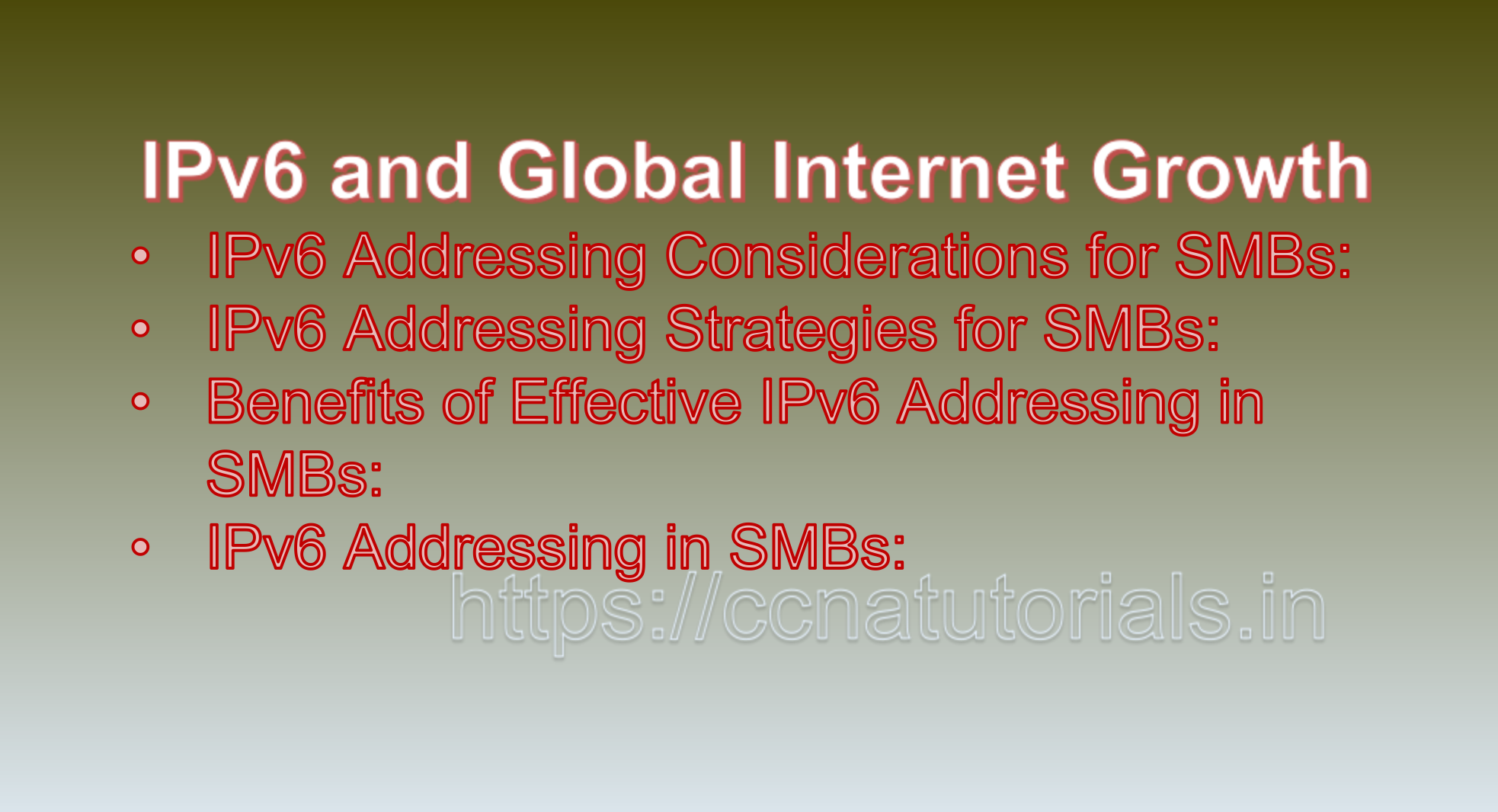Contents of this article
In this article, I describe IPv6 Addressing in Small Businesses: Embracing Efficiency and Growth. As the world transitions to Internet Protocol version 6 (IPv6) to overcome the limitations of IPv4, small businesses (SMBs) must also adapt to the new addressing scheme to accommodate the growing number of devices and services. IPv6 introduces a significantly larger address space, enabling more efficient addressing and improved network functionality. SMBs need to develop IPv6 addressing strategies that align with their size and operational requirements. This article explores IPv6 addressing considerations for SMBs and provides examples of how these considerations are implemented to facilitate efficient network management and support future growth.
1. IPv6 Addressing Considerations for SMBs:
– Abundant Address Space:
IPv6 provides a vast address pool, ensuring that SMBs have ample addresses to allocate without the fear of address exhaustion. This enables flexible addressing schemes and efficient subnetting.
– Hierarchical Structure:
IPv6’s hierarchical addressing design simplifies subnetting, routing, and network management. SMBs can leverage this structure to create an organized and scalable addressing plan.
– Simplicity and Ease of Management:
SMBs often have limited IT resources. IPv6’s simplified header format and autoconfiguration features ease network management and reduce administrative overhead.
– Security Considerations:
IPv6 offers enhanced security features, including support for Internet Protocol Security (IPsec). SMBs can implement these features to secure their network communications.
2. IPv6 Addressing Strategies for SMBs:
– Flat Addressing:
In this strategy, SMBs allocate a single large subnet for their entire network. While simple to manage, this approach doesn’t fully utilize IPv6’s capabilities and may lead to inefficient address usage.
– Hierarchical Addressing:
SMBs can adopt a hierarchical addressing plan, dividing their network into segments and allocating unique subnets to each segment. This approach aligns with IPv6’s design principles and simplifies routing and management.
– Role-Based Addressing:
Address blocks can be allocated based on device roles, such as servers, workstations, and IoT devices. This strategy enhances network organization and simplifies security measures.
3. IPv6 Addressing Strategy Examples:
– Flat Addressing Example:
– Small Office: A small office with limited IT resources opts for a flat addressing strategy. All devices in the office are assigned addresses from a single subnet. While this approach is straightforward, it may lead to inefficient address utilization as the network grows.
– Hierarchical Addressing Example:
– Medium-Sized Business: A medium-sized business with multiple departments implements hierarchical addressing. Each department is assigned its own subnet, making routing and management more efficient. The HR department, for instance, gets addresses from the prefix “2001:db8:1::/48,” while the sales department gets addresses from “2001:db8:2::/48.”
– Role-Based Addressing Example:
– Retail Store: A retail store adopts role-based addressing to simplify its network management. Devices are grouped based on roles, such as POS systems, security cameras, and guest Wi-Fi. For example, POS systems could use addresses from “2001:db8:3::/48,” while guest Wi-Fi devices use “2001:db8:4::/48.”
4. Implementation Steps for IPv6 Addressing in SMBs:
– Needs Assessment:
Evaluate the SMB’s current network structure, growth projections, and specific operational requirements to determine the most suitable addressing strategy.
– Address Allocation:
Allocate address blocks based on the chosen strategy, ensuring efficient utilization of IPv6’s vast address space.
– Address Assignment:
Decide on the method of address assignment, whether using stateful DHCPv6, stateless DHCPv6, or Stateless Address Autoconfiguration (SLAAC).
– Network Documentation:
Maintain clear documentation of the addressing plan, ensuring that IT staff can easily manage and troubleshoot the network.
5. Benefits of Effective IPv6 Addressing in SMBs:
– Optimal Address Usage:
Implementing a well-planned addressing strategy ensures efficient use of addresses, preventing wastage and conserving resources.
– Scalability:
SMBs can accommodate future growth by designing an addressing plan that easily scales with the addition of new devices and services.
– Simplified Management:
IPv6’s autoconfiguration features and hierarchical addressing simplify network management, reducing administrative burden.
– Enhanced Security:
Leveraging IPv6’s security features, such as IPsec, enables SMBs to secure their communications effectively.
6. Case Study: Role-Based Addressing Implementation:
– Small-Medium Business: A growing IT consulting firm adopts IPv6 to support its expanding operations. The firm implements a role-based addressing strategy to streamline network management.
Implementation:
– The firm categorizes devices into roles such as workstations, servers, and printers.
– Address blocks are allocated to each role based on their specific requirements. For instance, servers could use addresses from “2001:db8:5::/48,” while workstations use “2001:db8:6::/48.”
Benefits:
– The role-based addressing approach enhances network organization, making it easier to apply security measures and troubleshoot issues.
– As the firm grows, new devices can be assigned addresses within their designated role-based blocks, maintaining a structured and scalable network.

In short IPv6 Addressing in Small Businesses
IPv6 addressing in small businesses involves embracing the benefits of IPv6’s abundant address space, hierarchical structure, and simplified management features. Whether through hierarchical addressing, role-based addressing, or flat addressing, SMBs can create addressing plans that efficiently utilize addresses, streamline network management, and support future growth. By aligning IPv6 addressing strategies with their operational needs, SMBs can lay the foundation for a scalable, secure, and future-ready network infrastructure.
IPv6 Addressing in Small Businesses: Simplified Connectivity for Growth
Internet Protocol version 6 (IPv6) is a crucial advancement that addresses the limitations of Internet Protocol version 4 (IPv4) in accommodating the ever-expanding landscape of internet-connected devices. Small businesses (SMBs) are not exempt from the transition to IPv6. Embracing IPv6 is essential to ensure continued growth, efficient addressing, and streamlined network management. This article explores IPv6 addressing in SMBs, shedding light on its significance and providing examples to illustrate how SMBs can seamlessly integrate IPv6 into their network infrastructure.
1. IPv6 Addressing in SMBs:
– Address Exhaustion:
IPv4 has nearly exhausted its available address space, making it challenging for SMBs to acquire additional addresses for new devices and services. IPv6 provides an ample supply of addresses to cater to the growing needs of SMBs.
– Future-Proofing:
IPv6 offers a future-proof solution to address the proliferation of devices in the Internet of Things (IoT) era, enabling SMBs to expand their digital presence without facing address scarcity.
2. IPv6 Addressing Structure:
– IPv6 Address Format:
The IPv6 addresses are represented in eight groups of four hexadecimal digits, separated by colons. For example, 2001:0db8:85a3:0000:0000:8a2e:0370:7334.
– IPv6 Address Types:
IPv6 addresses are categorized into various types, including unicast, multicast, and anycast addresses, each serving distinct communication purposes.
– Subnetting:
IPv6 subnetting follows a hierarchical structure similar to IPv4. The larger address space allows SMBs to allocate subnets more generously, enhancing network flexibility.
3. IPv6 Adoption in SMBs:
– IPv6-Ready Infrastructure:
SMBs need to ensure their network infrastructure, including routers, switches, and firewalls, is IPv6-compatible to enable seamless communication.
– Address Assignment Methods:
SMBs can choose between Stateless Address Autoconfiguration (SLAAC) and Dynamic Host Configuration Protocol version 6 (DHCPv6) for assigning IPv6 addresses to devices on their networks.
4. IPv6 Addressing Strategies for SMBs:
– Simplicity:
SMBs can adopt simplified addressing schemes, avoiding complexities seen in IPv4 NAT configurations. Hierarchical addressing helps organize devices efficiently.
– Flat Addressing:
In cases where the SMB network is relatively small, flat addressing might be suitable. This strategy assigns a single address block to the entire network.
5. IPv6 Addressing Strategy Examples:
– Simplicity Example:
– Small Retail Business: A small retail store is expanding its operations and requires more devices for inventory management, sales, and customer service. The business adopts a simplified IPv6 addressing plan using hierarchical addressing. Devices in different departments receive addresses from designated subnets, making management and troubleshooting straightforward.
– Flat Addressing Example:
– Consulting Firm: A medium-sized consulting firm with a limited number of employees decides to implement IPv6 to prepare for future growth. Since the network is not extensive, the firm opts for flat addressing. All devices receive addresses from a single address block, simplifying the initial implementation.
6. Implementation Steps for IPv6 in SMBs:
– Infrastructure Assessment:
Evaluate the network infrastructure to ensure it supports IPv6, including routers, switches, and firewalls.
– IPv6 Deployment Plan:
Develop a clear plan outlining the implementation of IPv6, considering factors like addressing strategies and address allocation.
– Address Assignment:
Decide on an address assignment method (SLAAC or DHCPv6) and ensure devices receive IPv6 addresses correctly.
– Security Considerations:
Implement security measures such as firewalls and intrusion detection systems to protect IPv6-enabled devices from potential threats.
7. Benefits of IPv6 in SMBs:
– Address Abundance:
IPv6 offers a vast address space, preventing address scarcity and enabling SMBs to grow without address constraints.
– Simplified Management:
Hierarchical addressing and simplified configurations result in easier network management and troubleshooting.
– Future-Proofing:
By adopting IPv6, SMBs ensure they are well-prepared for the proliferation of IoT devices and expanding digital services.
8. Case Study: SMB IPv6 Adoption:
– Online Retail Startup: A startup online retail business wants to ensure it is ready for future growth and the increasing number of devices involved in its operations.
Implementation:
– The startup decides to implement IPv6 using simplified hierarchical addressing.
– The network infrastructure, including routers and switches, is upgraded to support IPv6.
– The startup adopts SLAAC for address assignment, allowing devices to automatically configure IPv6 addresses.
Benefits:
– The startup avoids address scarcity issues, ensuring that its growth is not hindered by limited addresses.
– By using hierarchical addressing, the startup keeps its network organized and easily manageable as it expands.
Conclusion for IPv6 Addressing in Small Businesses: Future-Proofing SMB Networks with IPv6:
IPv6 addressing offers SMBs a unique opportunity to future-proof their network infrastructure in the face of the growing digital landscape. With an abundance of addresses, simplified management, and scalability, SMBs can seamlessly integrate IPv6 into their operations. Whether through simplified or flat addressing, SMBs can leverage IPv6 to accommodate their current needs and position themselves for continued growth. By adopting IPv6, SMBs ensure their networks are ready to embrace the challenges and opportunities of a connected world.






